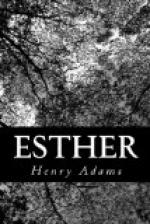Here Catherine Brooke was now enthroned as the light of the prairie, and day after day for three weeks, Esther labored over the portrait with as much perseverance as though Hazard were right in promising that it should make her immortal. The last days of November and the first of December are the best in the year for work, and Esther worked with an energy that surprised her. She wanted to extort praise from Mr. Wharton, and even felt a slight shade of responsibility towards Mr. Hazard. At first no one was to be admitted to see it while in progress; then an exception was made for Strong and Hazard who came to the house one evening, and in a moment of expansiveness were told that they would be admitted to the studio. They came, and Esther found Mr. Hazard’s suggestions so useful that she could not again shut him out. In return she was shamed into going to church with her aunt the following Sunday, where she heard Mr. Hazard preach again. She did not enjoy it, and did not think it necessary to repeat the compliment. “One should not know clergymen,” she said in excuse to her father for not liking the sermon; “there is no harm in knowing an actress or opera-singer, but religion is a serious thing.” Mr. Hazard did not know how mere a piece of civility her attendance was; he saw only that she was present, that his audience was larger and his success more assured than ever. With this he was well satisfied, and, as he had been used in life always to have his own way, he took it for granted that in this instance he had got it.
The portrait of course did not satisfy Esther. Do what she would, Catherine’s features and complexion defied modeling and made the artificial colors seem hard and coarse. The best she could paint was not far from down-right failure. She felt the danger and called Mr. Hazard to her aid. Hazard suggested alterations, and insisted much on what he was pleased to call “values,” which were not the values Esther had given. With his help the picture became respectable, as pictures go, although it would not have been with impunity that Tintoret himself had tried to paint the soul of the prairie.
Esther, like most women, was timid, and wanted to be told when she could be bold with perfect safety, while Hazard’s grasp of all subjects, though feminine in appearance, was masculine and persistent in reality. To be steadily strong was not in Esther’s nature. She was audacious only by starts, and recoiled from her own audacity. Before long, Hazard began to dominate her will. She felt a little uneasy until he had seen and approved her work. More than once he disapproved, and then she had to do it over again. She began at length to be conscious of this impalpable tyranny, and submitted to it only because she felt her own dependence and knew that in a few days more she should be free. If he had been clerical or dogmatic, she might have resented it and the charm would have broken to pieces on the spot, but he was for the time a painter like herself, as much interested in the art, and caring for nothing else.




